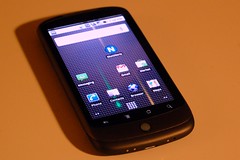I posted this guide to Hotsyncing my Pre with my netbook using My Tether as a wifi hotspot in Precentral in this thread. I am archiving it here on my blog because I don't want to have to spend a lot of time searching for it on Precentral's vast forums.
Running My Tether and Can't Hotsync? Use My Tether to Hotsync!
I'm not sure if this post will fall into the "Duh, we all knew that already" category or the "That's just crazy enough to work!" category but it's new to me and I haven't seen it on these forums.
I was thinking about doing a hard reset on my Classic PalmOS installation in hopes of getting it to perform better but wanted to do one final Hotsync in order to back it up. But I had been having a lot of trouble performing a Hotsync. Wifi? Failed. Bluetooth? Failed. Then I remembered reading in these forums that a lot of users of My Tether were having trouble hotsyncing.
So I had what seemed at the time to be a crazy idea. Since My Tether is doing a fairly good job of turning my Pre into a wifi Hotspot, why not tether my Pre to my netbook via wifi and do a wifi Hotsync that way? Since I was having no success in Hotsynching while connected to my home wifi network, this felt like a rather unlikely solution but I tried it anyway. And it worked.
So to summarize:
The Problem: Cannot Hotsync Classic via wifi or Bluetooth.
The Cause: Users of My Tether often suffer this problem and it is widely believed that My Tether is the culprit.
The Solution:
I was thinking about doing a hard reset on my Classic PalmOS installation in hopes of getting it to perform better but wanted to do one final Hotsync in order to back it up. But I had been having a lot of trouble performing a Hotsync. Wifi? Failed. Bluetooth? Failed. Then I remembered reading in these forums that a lot of users of My Tether were having trouble hotsyncing.
So I had what seemed at the time to be a crazy idea. Since My Tether is doing a fairly good job of turning my Pre into a wifi Hotspot, why not tether my Pre to my netbook via wifi and do a wifi Hotsync that way? Since I was having no success in Hotsynching while connected to my home wifi network, this felt like a rather unlikely solution but I tried it anyway. And it worked.
So to summarize:
The Problem: Cannot Hotsync Classic via wifi or Bluetooth.
The Cause: Users of My Tether often suffer this problem and it is widely believed that My Tether is the culprit.
The Solution:
- Launch both My Tether and Classic.
- Turn on wifi tethering in My Tether.
- Connect to your Pre as you would connect to any other wifi hotspot.
- Take note of the IP address which your Pre assigns to your computer.
- In Windows 7,
- Click on the wifi icon in your system tray to bring up your wifi network.
- Right click on your wifi network (by default My Tether calls itself, AoNet).
- Click on Status and then click on the Details button.
- Your IP adress will be listed in the Network Details box that comes up.
- In Windows XP,
- Your connection will sometimes put a network icon in your system tray.
- Click on it and select the Support tab of the status dialog that pops up.
- Your IP Address will be listed here.
or- If this icon is not in your system tray, open My Network Places instead.
- Click on View network connections in the sidebar and click on Wireless Network Connection.
- It will pop up the same status dialog as in the above example.
- In Windows 7,
- Launch the Hotsync app in Classic.
- Tap on Select PC.
- The Hotsync app will be unable to find a PC and will ask you to enter your PC's name or IP address by hand.
- Enter the IP address that your Pre assigned to your PC.
- Tap Done.
- Tap Hotsync.


![Reblog this post [with Zemanta]](http://img.zemanta.com/reblog_e.png?x-id=d13cac96-206f-4fdf-b8a8-c0eb32d4e706)

